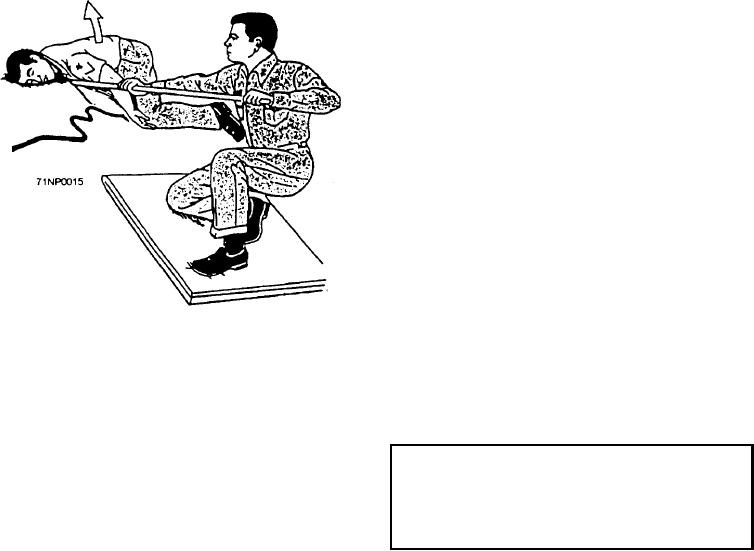
assume that breathing has stopped merely because a
person is unconscious or because a person has been
rescued from an electrical shock. Remember, DO NOT
GIVE ARTIFICIAL VENTILATION TO A PERSON
WHO IS BREATHING NATURALLY. There are two
methods of giving artificial ventilation: mouth-to-
mouth and mouth-to-nose.
For additional information on performing artificial
ventilation, refer to Standard First Aid Training Course,
NAVEDTRA 12081.
Cardiopulmonary Resuscitation
A rescuer who knows how to give cardiopulmonary
resuscitation (CPR) increases the chances of a victim's
survival. CPR consists of artificial ventilations and
external heart compressions. The lungs are ventilated
by the mouth-to-mouth or mouth-to-nose techniques;
Figure 1-9.--Pushing a victim away from a power line.
the compressions are performed by pressing the chest
with the heel of your hands. `he victim should be lying
face upon a firm surface. The procedure forgiving CPR
RESUSCITATION
is given in figure 1-10.
Methods of resuscitating or reviving an electric
shock victim include artificial respiration/ventilation (to
WARNING
reestablish breathing) and external heart massage (to
reestablish heart beat and blood circulation).
CPR should not be attempted by a
rescuer who has not been properly trained.
Artificial Ventilation
One-Rescuer Technique
A person who stopped breathing is not necessarily
dead but is in immediate critical danger. Life depends
The rescuer must not assume that an arrest has
on oxygen that is breathed into the lungs and then carried
occurred solely because the victim is lying on the deck
by the blood to every cell. Since body cells cannot store
and looks unconscious. First, try to arouse the victim
oxygen, and since the blood can hold only a limited
by gently shaking the shoulders and try to get a response;
amount (and only for a short time), death will result from
loudly ask, "Are you OK?" If there is no response, place
continued lack of breathing.
the victim face upon a firm surface. Kneel at a right
angle to the victim, and open the airway, using the head
The heart may continue to beat and the blood may
tilt-neck lift or the jaw thrust methods previously
still be circulated to the body cells for some time after
discussed. Look for chest movements. Listen and feel
breathing has stopped. Since the blood will, for a short
for air coming from the nose or mouth for at least 5
time, contain a small supply of oxygen, the body cells
seconds. If the pulse is absent, call for help and begin
will not die immediately. Thus, for a very few minutes,
CPR.
there is some chance that the person's life maybe saved.
A person who has stopped breathing but who is still alive
Locate the lower margin of the victim's rib cage on
is said to be in a state of respiratory failure. The first-aid
the side closest to you by using your middle and index
treatment for respiratory failure is called artificial
fingers. Then move your fingers up along the edge of
ventilation.
the rib cage to the notch (xiphoid process) where the ribs
The purpose of artificial ventilation is to provide a
meet the sternum in the center of the lower chest. Place
method of air exchange until natural breathing is
the middle finger on the notch, and place the index finger
next to it. Place the heel of the other hand along the
reestablished. Artificial ventilation should be given
only when natural breathing has stopped; it must NOT
midline of the sternum, next to the index finger. You
be given to any person who is still breathing. Do not
must keep the heel of your hand off the xiphoid process
1-19

